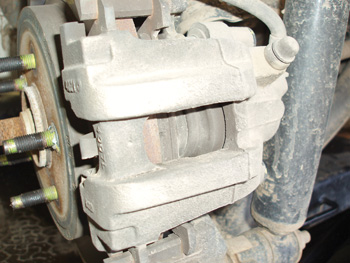Of the many changes taking place in modern brake service, replacing parts as an assembly rather than a unit is becoming one of the most important. To illustrate how the brake paradigm has changed, many shops routinely replace disc brake rotors rather than invest the time and resources to refinish them.
 Given that less machinable stock is available on a modern rotor, a brake technician might save perhaps one out of three rotors. But this happens only at the expense of wasting 30 minutes of valuable shop time during the attempt. So, on a purely statistical basis, the shop will make more money by replacing, rather than refinishing disc brake rotors. The same can be said for the other major disc brake parts like the disc brake caliper.
Given that less machinable stock is available on a modern rotor, a brake technician might save perhaps one out of three rotors. But this happens only at the expense of wasting 30 minutes of valuable shop time during the attempt. So, on a purely statistical basis, the shop will make more money by replacing, rather than refinishing disc brake rotors. The same can be said for the other major disc brake parts like the disc brake caliper.
Disc Brake Calipers
Since the disc brake caliper has the least number of moving parts of any major brake system component, it should be the most reliable. Of course, some disc brake calipers can last the life of the vehicle in the arid states west of the Mississippi River. In contrast, disc brake calipers most often live very short, unhappy lives in the rust-belt areas east of the Mississippi.
Similarly, if your customer uses his light truck to regularly tow fully loaded horse trailers over the high Rocky Mountains, you can rest assured that, more than once, his front disc brakes will turn cherry-red as he slows down for a hair-pin curve on a high mountain pass. Not only will brake pad and disc life suffer, the protective rubber boots on his disc brake calipers will begin to disintegrate with each occurrence.
Caliper Failure Symptoms
Since most production vehicles now incorporate four-wheel disc brakes, the disc brake caliper has become the heart of the braking system. The symptoms of caliper failure include a steering pull caused by a dragging front disc brake, the front brakes pulling during application, a rattling or chucking noise on “tar strip” bumps, and in many cases, a squealing or grinding noise as the brakes are applied.
A steering pull or braking pull is usually caused by the disc caliper not fully releasing pressure against the disc brake pad. In most cases, the protective rubber boot on the caliper piston is cracked or perforated, which allows water to enter and corrode the caliper piston bore. As a result, the caliper piston tends to stick in the caliper bore, forcing the disc pads to drag against the rotating disc brake caliper.
Brake Caliper Service
Like disc brake rotors, disc calipers are more easily replaced than serviced. Since the caliper’s main casting is rarely damaged, the remanufacturer cleans the caliper and installs a new piston, piston o-ring and exterior seal. In most cases, the remanufacturer includes new caliper mounting hardware that promotes a smooth release of braking force against the brake pads. In many cases, remanufacturers also supply “loaded” calipers that include new brake pads and mounting shims, if required, and new copper gaskets to seal the caliper against the brake hose.
And, speaking of brake hoses, it’s always good policy to prevent a possibly catastrophic hydraulic failure by suggesting a new brake hose to go with the reman caliper. The condition of the master cylinder should generally be determined by testing the brake pedal for a firm application and by inspecting for leakage and for sediment in the cylinder’s reservoir.
If the disc caliper incorporates a park brake assembly, the auto manufacturer’s procedures should be followed if an adjustment in required. When the new disc rotors, calipers and pads are assembled, the braking system should be thoroughly flushed with new, OE-specified brake fluid. So when it’s time to sell brake parts, let’s change our thinking from “brake parts” to “brake assembly.” In the long-term, changing our basic paradigm for brake repairs will result in a safer, more profitable enterprise for all concerned.







